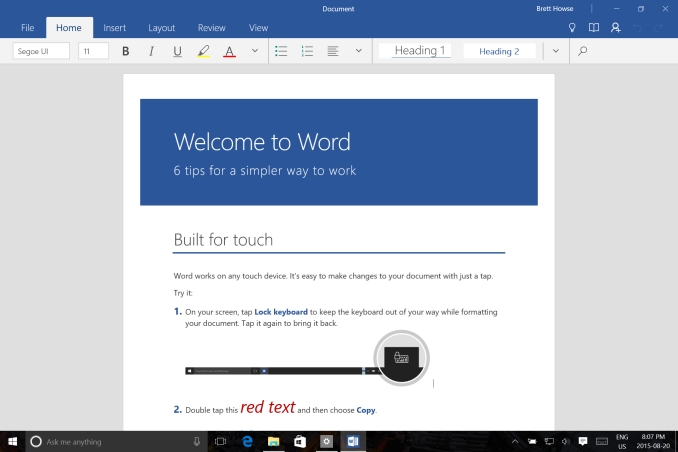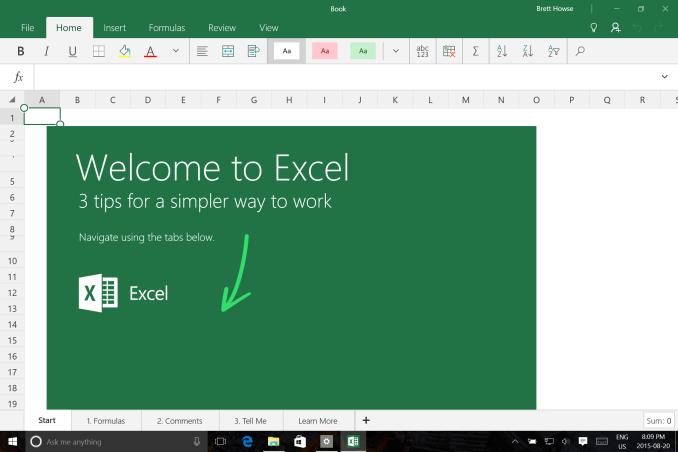The Windows 10 Review: The Old & New Face of Windows
by Brett Howse on August 25, 2015 8:00 AM EST- Posted in
- Operating Systems
- Microsoft
- Windows 10
Touch-Enabled Office Apps Arrive with Windows 10
When Windows 8 launched, Microsoft had built a touch-first version of their operating system, but they had not yet completed their touch-enabled version of their most popular productivity suite. In fact, in the almost three years between Windows 8 and Windows 10, Microsoft released Office on iOS first, and then Android, leaving their own platform as the only one without a touch-enabled version of Office. Finally, with Windows 10, Office Mobile is here.
These are, like practically all pieces of Windows 10, Windows Universal Apps, and therefore they are made to scale all the way from a phone to a large display desktop. Word, Excel, PowerPoint, and OneNote are all available. The experience is very similar to how it looks on the other platforms, and Microsoft has done a nice job keeping the look and feel consistent across the different mobile operating systems.
I think most people are familiar with the Office trio of Word, Excel, and PowerPoint, and perhaps not quite as familiar with OneNote, but the mobile apps are surprisingly competent versions, and can likely easily replace the full Office suite for a lot of people. If you need some of the extra functionality like conditional formatting in Excel, or the ability to open password protected documents, you will need to go with the full version of Office, at least for now.
In pretty typical Microsoft fashion, the apps have been created to allow basic file reading, creation, and editing for free, but if you want to access all of the features you need to purchase an Office 365 subscription. There is a big caveat here though. This only applies to devices under 10.1 inches in screen diameter. Anything larger than this requires a subscription to gain access to edit, which is a pretty big concession. According to Microsoft, they want to keep the free capabilities available for devices that are mostly used with touch, and the Office team feels this cut-off is 10.1 inches. Amazingly, the same company also sells a consumer version of their tablet line, the Surface 3, which is a 10.8 inch device and therefore over the cut-off. They do sell it with a one year subscription, but it’s a rather odd way to market the new Office Mobile apps.
There is also a new piece to the Office puzzle, which is called Sway. Luckily, like OneNote, Sway is free for all users. So what is Sway? It is an interactive storytelling app, and it lets you easily add some text and media, and it will create a sway for you. It’s very much a cloud based app, and you can share links to your sway to view or edit. Think of it like a simpler version of PowerPoint. Here is a sway as an example of what it can do.
OneNote is of course back, and this is Microsoft’s app which lets you do a lot more than just take notes. The touch version is changed from Windows 8, and it now fits in with the theme of the other Office Mobile apps. Fans of the Windows 8 version’s radial menu will be disappointed though since that has gotten the axe.
I think the capabilities of these apps are going to improve over time, but it is unlikely they will ever offer the full functionality of the desktop version of Office. They are targeted towards a different set of needs. It was certainly one of the key missing pieces of the Windows 8 era, so it is great that they have made their debut with Windows 10. Only OneNote is installed out of the box, and the other apps can be found in the store.














293 Comments
View All Comments
minijedimaster - Tuesday, August 25, 2015 - link
^TROLL^galta - Tuesday, August 25, 2015 - link
Maybe... Or maybe you miss basic reading skills. Who could know?Michael Bay - Tuesday, August 25, 2015 - link
Four transitions as of now for me, two from 7 and two from 8.Aside from some video driver issues on nV desktop and intel notebook right after installing, it was a remarkably smooth sailing.
andrewaggb - Tuesday, August 25, 2015 - link
I've upgraded over 10 pc's, only 1 had a problem and automatically rolled by to 8.1 (I ended up doing a fresh install of 10 on this machine). Some were running 7 and most were running 8.1kmmatney - Tuesday, August 25, 2015 - link
Same here - 2 computer from Windows 8.1 (one a tablet), and 3 computers from Windows 7. For 2 of the Windows 7 machines, I was able to upgrade from 32-bit Windows 7 to 64-bit. That was the main reason why I took the free upgrade - to go to 64-bit. There are certainly a few things that annoy me, but overall I can't complain. Funnily enough, the one system where I don't like the upgrade is my tablet - it seems way too laggy. Part of that may be that it still seems to be constantly updating itself.Michael Bay - Wednesday, August 26, 2015 - link
My tablet is M80ta, so I have no real use for x64 on ot. Runs well, I was pleasantly surprised when it understood that I want stilus input when I got it out.If anything, I wish Brett would write more about the tablet side of 10, which became much better compared to 8.
khanikun - Wednesday, August 26, 2015 - link
Win 10 sucks on my Surface 3. Seems fine on my Surface Pro 3. Not much to say about the SP3, but it really feels like I'm getting beta updates on my Surface 3. When I first got it, it was pretty junky. The touchscreen seemed to lag and I'd have to touch it a few times to get it to start registering that I was well...touching it. That was on Win 8 or whatever version came stock, I don't even remember.I went to Win 10 and not much change. Then an update came and it worked great. No issues with the touchscreen. A couple weeks ago, the problem came back again with another update. Also touch seems to not register very well at the taskbar. Which was a non-issue with Win 8.
Either way, rolling back to Win 8.1. I hate that the power button is in the start menu, cause on a 1080p screen that's only 10-12", it's ridiculously small. I also hate that I can't pick/choose what updates I want. On Win 10 Pro, I can delay updates, but I can't pick/choose. So back to 8.1.
Michael Bay - Wednesday, August 26, 2015 - link
Have you considered turning your unit to warranty service? Non-registering touch is itself a reason enough.chrome_slinky - Wednesday, August 26, 2015 - link
It really is ANNOYING to see people call the "upgrade" free. It is not. It is a license trade - NOTHING MORE. In 30 days from "upgrading" you can no longer use the key for the previous OS to go back.Brett Howse - Wednesday, August 26, 2015 - link
That's not correct you can always use your key to go back, but after 30 days the automated recovery to allow you to go back removes the old Windows.old folder it saved during the upgrade to allow you to roll back from Windows 10 to 7 or 8.1. You seem to be a bit confused there so sorry about not making it more clear in the article. You would have to delete your partition and reinstall 7/8.1 with the old key.